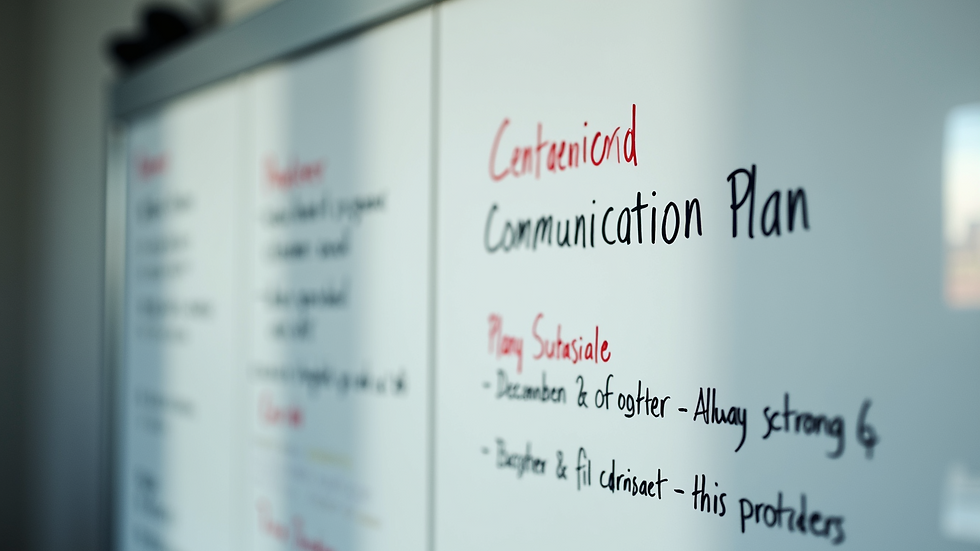Crafting Effective Creative Communication Strategies
- Subbu Shastri

- Nov 17
- 4 min read
In today’s fast-paced world, communication is more than just exchanging information. It is about connecting, inspiring, and driving meaningful change. We specialize in cause communication, combining creativity, collaboration, and strategic approaches to amplify impact for our clients. Partnering closely with media entrepreneurs, small businesses, and social impact organizations, we develop compelling messages that resonate deeply with their audiences. This blog post explores how to craft effective communication methods that truly make a difference.
Understanding Effective Communication Methods
Effective communication methods are the foundation of any successful campaign or initiative. They ensure your message is clear, engaging, and actionable. But what makes communication truly effective? It’s a blend of clarity, relevance, emotional connection, and strategic delivery.
Clarity: Avoid jargon and complex language. Use simple, direct sentences that your audience can easily understand.
Relevance: Tailor your message to the interests, values, and needs of your audience.
Emotional Connection: Stories, visuals, and authentic voices help create empathy and engagement.
Strategic Delivery: Choose the right channels and timing to maximize reach and impact.
For example, when working with a small business promoting eco-friendly products, we focus on highlighting the environmental benefits in a way that feels personal and urgent. This approach helps customers see the value beyond just the product.

Building Blocks of Creative Communication Strategies
To truly stand out, you need to go beyond traditional methods. This is where creative communication strategies come into play. These strategies combine innovation with purpose, helping your message cut through the noise.
Here are some key building blocks:
Audience Insight
Deeply understand who you are talking to. What motivates them? What challenges do they face? Use surveys, interviews, and social listening to gather insights.
Compelling Storytelling
Stories are powerful tools. They humanize your cause and make abstract ideas tangible. Use real-life examples, testimonials, and narratives that evoke emotion.
Visual Impact
Incorporate strong visuals like infographics, videos, and photography. Visuals increase retention and make your message more shareable.
Collaborative Approach
Work with partners, influencers, and community members. Collaboration expands your reach and adds credibility.
Consistent Messaging
Ensure your message is consistent across all platforms and touchpoints. Consistency builds trust and recognition.
For instance, a social impact organization we worked with used a series of short videos featuring beneficiaries telling their own stories. This approach created authenticity and boosted engagement significantly.

Crafting Messages That Resonate
The heart of any communication strategy is the message itself. Crafting messages that resonate requires empathy and precision.
Use the Audience’s Language: Speak in terms your audience uses daily. Avoid corporate speak or overly technical terms.
Highlight Benefits, Not Features: Instead of listing what your product or service does, explain how it improves lives or solves problems.
Create a Call to Action: Every message should inspire some form of action, whether it’s visiting a website, signing a petition, or sharing content.
Test and Refine: Use A/B testing or focus groups to see which messages perform best and refine accordingly.
For example, when communicating for a media entrepreneur launching a new podcast on social issues, we emphasized the podcast’s role in sparking conversations and inspiring change, rather than just its content format.
Leveraging Digital Platforms for Maximum Reach
Digital platforms offer unparalleled opportunities to amplify your message. However, each platform has its own culture and best practices.
Social Media: Use platforms like Instagram, Twitter, and LinkedIn to share bite-sized, engaging content. Use hashtags and trends to increase visibility.
Email Marketing: Personalize emails and segment your audience to deliver relevant content.
Websites and Blogs: Maintain a regularly updated blog with valuable content that supports your cause.
Video Platforms: YouTube and TikTok are great for storytelling and demonstrations.
Remember to monitor analytics to understand what works and adjust your strategy accordingly. For example, a small business client saw a 40% increase in engagement after shifting from generic posts to interactive Instagram stories featuring behind-the-scenes content.
Measuring Impact and Adapting Strategies
No communication strategy is complete without measuring its impact. Use both qualitative and quantitative metrics to evaluate success.
Engagement Metrics: Likes, shares, comments, and click-through rates.
Reach Metrics: Number of people who saw your message.
Conversion Metrics: Actions taken, such as donations, sign-ups, or purchases.
Sentiment Analysis: Understanding how people feel about your message.
Based on these insights, adapt your strategies to improve effectiveness. For example, if video content is driving more engagement than text posts, allocate more resources to video production.
Moving Forward with Purpose and Creativity
Crafting effective communication methods is an ongoing journey. It requires a balance of creativity, strategy, and empathy. By focusing on clear messaging, understanding your audience, and leveraging the right tools, you can amplify your impact and drive meaningful change.
We are committed to partnering with you to develop communication solutions that not only inform but inspire action. Together, we can create messages that resonate, engage, and transform.
If you want to explore more about how to implement these ideas, feel free to visit creative communication strategies for additional insights and resources.
.png)


Comments